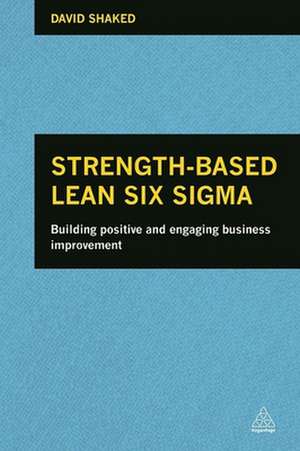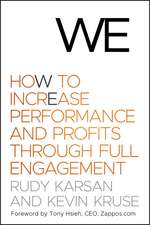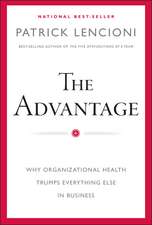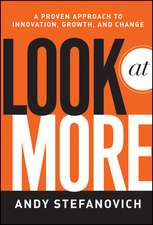Strength–Based Lean Six Sigma – Building Positive and Engaging Business Improvement
Autor David Shakeden Limba Engleză Paperback – 2 noi 2013
Achieving greater efficiency and effectiveness have always been very important for both for-profit and public sector organizations. Many organizations and government agencies mandate Lean programs in the hope of achieving these objectives, but often these programs underperform and result in resistance.
Strength-based Lean Six Sigma helps increase the level of employees’ engagement with Lean initiatives by shifting the conversation from “what is not efficient or non-value-add and needs to be removed/reduced” to “what is already efficient/value adding and can be built upon or expanded.” Combining the energy and motivation released through a strengths-based approach with the focus on quality and efficiency generated by Lean Six Sigma, the book offers practitioners the opportunity to understand each other and work successfully together to drive effective and powerful change programs.
Strength-based Lean Six Sigma helps increase the level of employees’ engagement with Lean initiatives by shifting the conversation from “what is not efficient or non-value-add and needs to be removed/reduced” to “what is already efficient/value adding and can be built upon or expanded.” Combining the energy and motivation released through a strengths-based approach with the focus on quality and efficiency generated by Lean Six Sigma, the book offers practitioners the opportunity to understand each other and work successfully together to drive effective and powerful change programs.
| Toate formatele și edițiile | Preț | Express |
|---|---|---|
| Paperback (1) | 397.46 lei 6-8 săpt. | |
| Kogan Page – 2 noi 2013 | 397.46 lei 6-8 săpt. | |
| Hardback (1) | 973.70 lei 6-8 săpt. | |
| Kogan Page – 2 ian 2015 | 973.70 lei 6-8 săpt. |
Preț: 397.46 lei
Nou
Puncte Express: 596
Preț estimativ în valută:
76.08€ • 82.67$ • 63.95£
76.08€ • 82.67$ • 63.95£
Carte tipărită la comandă
Livrare economică 21 aprilie-05 mai
Preluare comenzi: 021 569.72.76
Specificații
ISBN-13: 9780749469504
ISBN-10: 0749469501
Pagini: 264
Dimensiuni: 155 x 235 x 10 mm
Greutate: 0.38 kg
Editura: Kogan Page
ISBN-10: 0749469501
Pagini: 264
Dimensiuni: 155 x 235 x 10 mm
Greutate: 0.38 kg
Editura: Kogan Page
Cuprins
Acknowledgements
Introduction
Navigating this book
PART ONE Define
01 Approaches to organizational change and process improvement
Historical context
Developments in organizational change and change management
Six Sigma
Lean Thinking
Lean Six Sigma
Summary
02 Strength-based approaches to change
Strength-based approach 1: Appreciative Inquiry
Strength-based approach 2: Solution Focus coaching
Strength-based approach 3: Positive Deviance
Shared themes between the key strength approaches
The differences between the strength-based approaches
Other complementary tools and approaches
Learning more about strength-based change
Summary
PART TWO Discover
03 The birth of Strength-based Lean Six Sigma
A journey of discovery and emergence
Problem-solving experience built, Appreciative Inquiry discovered – now what?
Appreciating all my skills and building bridges between them
Summary
04 Strength-based approaches and their potential contribution to Lean Six Sigma
Appreciative Inquiry
Solution Focus
Positive Deviance
Summary
05 The principles behind the strength-based approach to Lean Six Sigma
How have these principles shaped Lean Six Sigma practice and tools?
Introducing the Appreciative Inquiry principles
What do the Appreciative Inquiry principles mean in the context of Lean Six Sigma?
Additional principles to consider from Solution Focus and Positive Deviance, and their meaning for Lean Six Sigma
Summary
06 Exploring the ‘positive core’
Exploring the best of Lean Six Sigma
Exploring the best of Appreciative Inquiry, Solution Focus and Positive Deviance
Exploring the best in yourself as a change agent/improvement practitioner
Exploring the best in the system(s) you are working with
Exploring your hopes for the future
Summary
PART THREE Dream
07 What is Strength-based Lean Six Sigma?
How do I defi ne Strength-based Lean Six Sigma?
Why this combination?
Why not stick to either one approach or the other
Summary
08 The vision for a Strength-based Lean Six Sigma practice
Shifting to a new paradigm – key assumptions to reconsider
Being Strength-based Lean Six Sigma (instead of thinking or doing)
Our key objectives – quality, fl ow and value
What about continuous learning and improvement?
Summary
09 Strength-based metrics and performance review
How to apply strength-based thinking to scorecards – a few pointers
The leadership opportunity – an invitation to think and act differently
Summary
10 Approaches to Strength-based Lean Six Sigma
The whole organization
A priority process
A project
The project or process team
The tools we use
Getting started
Summary
PART FOUR Design
11 The Strength-based Lean Six Sigma Tools
Wishbone analysis/success cause analysis
The ‘value walk’ and the ‘seven signs of value’
Process/value-stream mapping
Gemba/Genbutsu (‘go see’)
Strength-based five-Why’s
A3 template
Summary
12 The Strength-based Lean Six Sigma process – classic frameworks with a fresh twist
PDCA/PDSA
DMAIC
5D
Summary
13 A proposed design for a strength-based Kaizen event
The Kaizen ‘define’ stage
Setting up for success
The Kaizen event – Discover and Dream
The Kaizen event – Design and Deliver
Closing the Kaizen event 1
The Kaizen event – follow up
Summary
14 Moving beyond frameworks and tools
Developing strength-focused eyes
Summary 1
PART FIVE Deliver/Destiny
15 Introducing Appreciative Inquiry to organizations practising Lean Six Sigma
What is important to consider when introducing the topic?
How to introduce: tips for success
Summary
16 Defining the topic of inquiry
How to uncover great topics
Creating a platform for change
Summary
17 Strength-based Lean Six Sigma case stories
Challenge 2: Engaging everyone in improvements
Challenge 3: Managing daily improvement activities from a strength-based perspective
Summary
18 Destiny – opening the door to the future of Strengthbased Lean Six Sigma
The full spectrum of possibilities for the second generation
The case for the third generation according to Jeremy
Summary
Appendix A: A comparison of deficit - and strength-based problem solving
Appendix B: Where to learn more about strength-based change
References
Index
Introduction
Navigating this book
PART ONE Define
01 Approaches to organizational change and process improvement
Historical context
Developments in organizational change and change management
Six Sigma
Lean Thinking
Lean Six Sigma
Summary
02 Strength-based approaches to change
Strength-based approach 1: Appreciative Inquiry
Strength-based approach 2: Solution Focus coaching
Strength-based approach 3: Positive Deviance
Shared themes between the key strength approaches
The differences between the strength-based approaches
Other complementary tools and approaches
Learning more about strength-based change
Summary
PART TWO Discover
03 The birth of Strength-based Lean Six Sigma
A journey of discovery and emergence
Problem-solving experience built, Appreciative Inquiry discovered – now what?
Appreciating all my skills and building bridges between them
Summary
04 Strength-based approaches and their potential contribution to Lean Six Sigma
Appreciative Inquiry
Solution Focus
Positive Deviance
Summary
05 The principles behind the strength-based approach to Lean Six Sigma
How have these principles shaped Lean Six Sigma practice and tools?
Introducing the Appreciative Inquiry principles
What do the Appreciative Inquiry principles mean in the context of Lean Six Sigma?
Additional principles to consider from Solution Focus and Positive Deviance, and their meaning for Lean Six Sigma
Summary
06 Exploring the ‘positive core’
Exploring the best of Lean Six Sigma
Exploring the best of Appreciative Inquiry, Solution Focus and Positive Deviance
Exploring the best in yourself as a change agent/improvement practitioner
Exploring the best in the system(s) you are working with
Exploring your hopes for the future
Summary
PART THREE Dream
07 What is Strength-based Lean Six Sigma?
How do I defi ne Strength-based Lean Six Sigma?
Why this combination?
Why not stick to either one approach or the other
Summary
08 The vision for a Strength-based Lean Six Sigma practice
Shifting to a new paradigm – key assumptions to reconsider
Being Strength-based Lean Six Sigma (instead of thinking or doing)
Our key objectives – quality, fl ow and value
What about continuous learning and improvement?
Summary
09 Strength-based metrics and performance review
How to apply strength-based thinking to scorecards – a few pointers
The leadership opportunity – an invitation to think and act differently
Summary
10 Approaches to Strength-based Lean Six Sigma
The whole organization
A priority process
A project
The project or process team
The tools we use
Getting started
Summary
PART FOUR Design
11 The Strength-based Lean Six Sigma Tools
Wishbone analysis/success cause analysis
The ‘value walk’ and the ‘seven signs of value’
Process/value-stream mapping
Gemba/Genbutsu (‘go see’)
Strength-based five-Why’s
A3 template
Summary
12 The Strength-based Lean Six Sigma process – classic frameworks with a fresh twist
PDCA/PDSA
DMAIC
5D
Summary
13 A proposed design for a strength-based Kaizen event
The Kaizen ‘define’ stage
Setting up for success
The Kaizen event – Discover and Dream
The Kaizen event – Design and Deliver
Closing the Kaizen event 1
The Kaizen event – follow up
Summary
14 Moving beyond frameworks and tools
Developing strength-focused eyes
Summary 1
PART FIVE Deliver/Destiny
15 Introducing Appreciative Inquiry to organizations practising Lean Six Sigma
What is important to consider when introducing the topic?
How to introduce: tips for success
Summary
16 Defining the topic of inquiry
How to uncover great topics
Creating a platform for change
Summary
17 Strength-based Lean Six Sigma case stories
Challenge 2: Engaging everyone in improvements
Challenge 3: Managing daily improvement activities from a strength-based perspective
Summary
18 Destiny – opening the door to the future of Strengthbased Lean Six Sigma
The full spectrum of possibilities for the second generation
The case for the third generation according to Jeremy
Summary
Appendix A: A comparison of deficit - and strength-based problem solving
Appendix B: Where to learn more about strength-based change
References
Index
Notă biografică
David Shaked is a certified Lean Six Sigma Master Black Belt with experience on-the-ground implementing and teaching these approaches of different organizations and functions. He is also an AI practitioner and trainer, certified by NTL, the leading organization in the US for teaching OD practice. He founded Almond Insight, a change management consulting company that helps organizations solve business challenges in sales, marketing, finance, customer services, distribution and human resources.












